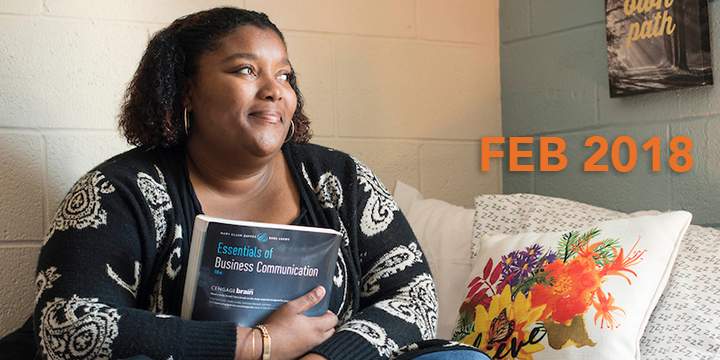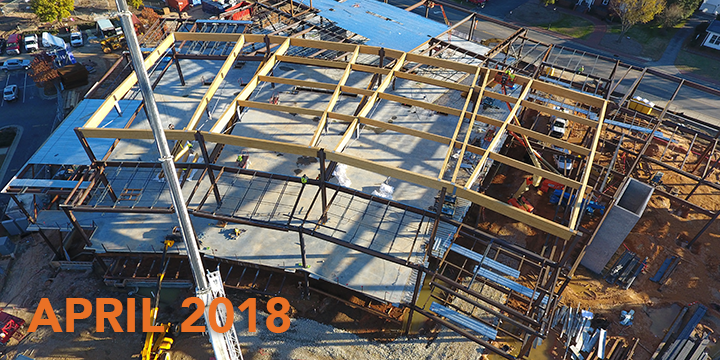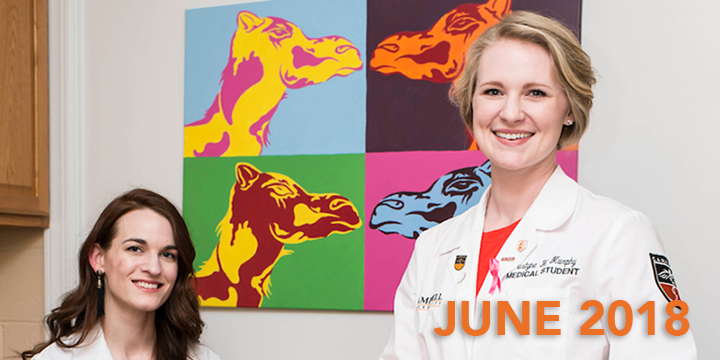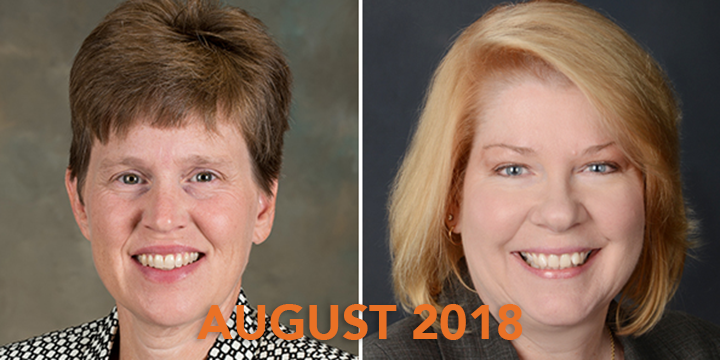This time next year, the transformation of Campbell University’s main campus in Buies Creek — a process that began with the addition of the Convocation Center a decade ago — will be complete.
That is, until the next building goes up.
The centerpiece of this facelift will be the 110,000-square-foot student union, which is expected to open in the fall of 2019.
This year saw the groundbreaking and start of construction for the facility, a long-needed amenity that is expected to become the “living room” for not only Campbell’s undergrads who live on campus, but also faculty and staff, grad students, alumni and other visitors.
Its neighbor, the McLeod Admissions & Financial Aid Building, opened in 2018, another needed addition and much-improved “first impression” for prospective students and their families.
But the year was about much more than new buildings. Campbell made big strides in improving attention provided to first-generation college students and continued to build on its standing as a national leader in rural health advocacy. A new marching band took the field for the first time in the fall, playing halftime for Campbell’s first FCS scholarship football program, which joined the Big South Conference this year.
To celebrate the end of Campbell’s 131st year, we’re taking a look back at the 10 moments that best defined the University’s 2018. The events below are in chronological order and not ranked in order of importance:
1) First-generation college students offered much-needed guidance
The Winter 2018 edition of Campbell Magazine featured four first-generation college students who revealed personal stories of the struggles most students like them experience at schools across the country.
Campbell University, like most schools, is made up of roughly 30-35 percent first-generation students (those whose parents did not graduate from a four-year college or university).
Students who enter with that tag are, statistically, at a disadvantage from Day 1 compared to those whose parents have experienced the rigors of college. Being a first-generation student is one of the most cited predictors of higher education failure, according to the First Generation Foundation, a national nonprofit dedicated to reversing this. These students are less likely to graduate — more than a quarter of them drop out after their first year (four times the rate of their peers).
Recognizing the need to better support the needs of first-generation students, Campbell announced in February that it intended to launch a one-year pilot mentoring program designed to provide mentor relationships for students with University faculty, staff and alumni who were also the first in their families to earn a degree.
The mentor program, led by Assistant Vice President for Student Success Michelle Perez, launched in the fall. In addition to simply being there for advice or support for these students, the mentors took part in several social events on campus throughout the semester.
“The mentor program has been a blessing,” says Brittany Farman, a criminal justice/pre-law major. “My mentor has been a support system I didn’t even know I needed.”
2) Ground broken, construction begins on massive student union
Since ground broke on the student union in April, the building’s footprint has become visible. The foundation has been laid, the beams are up and portions of the roof have already gone up. Already, it’s an impressive site. And sight. Seeing the building take shape in 2018 has us excited about what’s to come in late 2019.
The University came together on April 25 to mark the ceremonial beginning of construction of the facility expected to become a “transformative” addition to the campus, providing a much-needed center of activity for the Campbell community.
“When I talk to prospective students about this building, it’s hard to relay to them just how massive this will be — something you don’t see by looking at dirt or a few renderings in a magazine,” said Assistant Vice President of Admissions Jason Hall. “That’s why [the groundbreaking ceremony] is so very special. It marks a beginning. Soon, a foundation will form, and a skeleton will rise to outline the progress. When I tell them this will be larger than the convocation center, I’m usually met with raised eyebrows, a smile and maybe the occasional ‘whoa.’”
The student union will be roughly 10 times the size of Campbell’s existing Wallace Student Center, built in 1978. The facility is the focal point of the Campbell Leads fundraising campaign, which allotted $35 million for its construction.
The union will feature a lighted glass tower and a facade made almost entirely of glass, allowing students to enjoy a scenic view of campus and the iconic Kivett Hall. Inside, the facility will be designed to promote community. By offering spaces where students can eat, shop, plan projects, play games and watch sports and movies together, the student union will get students out of their dorm rooms and involved on campus. Part-time and commuting students will also have more options for places to study and relax between classes.
The student union will also focus on health and wellness with amenities to help students develop healthy lifestyles. Locker rooms, free weights and weight machines will round out a two-story fitness facility. With spaces for group fitness classes and intramural sports, the new design doubles the area of the current fitness center. Outside the fitness center will be fresh dining options, including a juice bar and produce stand to fuel students’ study sessions and routines.
“The great thing about this facility is it incorporates everything we have now for student services, plus new residential dining, a two-story fitness center, and a banquet hall.” said Jim Roberts, Campbell’s vice president for business and treasurer. “All of the spaces that we use for student activities right now, like the convocation center, will be opened up for better use, while students will have everything they need in one central location. This is going to allow the community to expand all across campus.”
3) First class of nurses graduates; school gets accreditation
Nancy Duffy will likely see hundreds and hundreds of students earn their Bachelor of Science in Nursing degrees before her career is over. But that first class will always hold a special place in her heart.
“I know them by name, by face and I can probably tell you a story or something interesting about every single one of them,” said the director of Campbell’s nursing program. “That will certainly be difficult to do in the future — to maintain that level of familiarity every year. But I’m going to try.”
The Catherine W. Wood School of Nursing graduated 44 students during the 29th commencement of the College of Pharmacy & Health Sciences in May. The first commencement came nearly two years after the program accepted its first group of juniors at the new Tracey F. Smith Hall of Nursing & Health Sciences in fall 2016.
Unlike most majors within a university system, Campbell Nursing does not enroll students until they are juniors or have met all the program requirements and fulfilled all program prerequisites. Getting the general curriculum out of the way allows the students to focus on the rigorous nursing curriculum that involves patient care and clinical experiences during their junior and senior years.
According to Duffy, 46 students started the program back in 2016 — only one student left the program and another will graduate at a later date. She called Campbell Nursing’s first retention rate “remarkable.”
Only days after the commencement ceremony, Duffy received the news that the program was granted full accreditation status by the Commission on Collegiate Nursing Education (CCNE).
“Getting the news was extremely exciting, but also a huge relief,” she said. “After years of planning, paperwork, meetings and site visits, we were fairly confident our program would be granted accreditation. But until the official word comes down, there is always the thought in the back of your mind that maybe the news will not be good. We are thrilled that our news was good.”
4. Campbell grows as national leader in rural health advocacy
The Spring 2018 edition of Campbell Magazine highlighted the “Power of Rural” — the innovators and advocates at Campbell who are working to improve the health and way of life for millions of North Carolinians and Americans living in rural communities.
The magazine highlighted Lillington hog farmer Tom Butler, recipient of Campbell’s first Rural Health Advocacy award and an innovator when it comes to recycling methane from toxic hog waste and putting it back into the electric grid to power homes in the surrounding community.
Other stories:
- The launch of Campbell’s Rural Philanthropic Analysis, an 18-month national exploration — funded by a grant from the Robert Wood Johnson Foundation — designed to create, identify and enhance new ideas and insights to improve the practice and impact of charitable organizations when it comes to supporting healthy, equitable rural communities.
- Campbell’s health science programs’ work with the North Carolina Farmworker Health Program, whose function is to improve the health of migrant and seasonal workers and their families (of which 80 percent do not receive health care) through funding, training and other assistance to a network of outreach and health care providers.
- The work of Campbell’s Student Clinic, overseen by licensed physicians and School of Medicine faculty but otherwise run by medical, physician assistant, pharmacy, social work and other health sciences students. The clinic has become a major asset for Harnett County’s low-income and medically uninsured population (which is larger, percentage-wise, than the average county). Every Tuesday night, the students see more than a dozen patients (there are currently 200 uninsured patients in their system) seeking treatment and care for chronic pain, hypertension, diabetes and a slew of other conditions that would otherwise go untreated.
- Campbell’s Public Health program and chair David Tillman. The program is unique in that it is specifically tailored to focus on rural health. It’s one of six schools in the nation with a rural focus, only two of which are located east of the Mississippi river, and it is the only Association of Schools & Programs of Public Health-accredited program in the country that both focuses on rural health and is actually located in a rural area.
Learn more about Campbell’s commitment to rural health in 2018.
5. Beam, Yerk-Zwickl named to University Cabinet
Faithe Beam and Sherri Yerk-Zwickl joined Campbell’s University Cabinet as associate vice presidents in August — the first women to earn this distinction in the University’s 131-year history.
Creed said the changes grew from the University’s strategic plan, and they reflect the importance of Campbell’s mission. Beam, who also serves as campus minister, is now associate vice president for spiritual life; and Yerk-Zwickl’s new role, in addition to chief information officer, is associate vice president for information technology.
The appointments topped the many accolades and administrative appointments for women at Campbell University in 2018. On a lighter note, Campbell Athletics also announced this year that Gladys — the female camel mascot that had a brief run in the early 1990s — would return to the sidelines for sporting events next year.
Campbell also played host to the first Women’s Leadership Conference in March — coordinated by Campbell Title IX Coordinator Kellie Nothstine and Campbell Athletics, the Summit not only provided the students valuable lessons in climbing the career ladder, but also one-on-one meetings with mentors eager to answer questions and offer sage advice.
In February 2019, Founders Week will pay tribute to the many women in Campbell’s long history who have made the University what it is today.
6. Campbell football turns 10, joins the Big South, adds scholarships, wins
When the Campbell Fighting Camels kicked off the 2018 season on Aug. 30, they lined up for the first time as a scholarship football program and a member of the Big South Conference after 10 years as a non-scholarship program that started from nothing.
Without a doubt, the new era began with a successful season.
The Camels made history by getting its first wins over non-conference FCS foes Georgetown, North Alabama and Wagner. Campbell also got its first Big South win, 34-6 over Presbyterian on Nov. 10. At 6-5 overall, the Camels secured back-to-back winning seasons for the first time in the program’s modern era (since 2008), and tied an overall program record for victories.
The program’s “remarkable rise” was the cover story of the Fall 2018 edition of Campbell Magazine, which chronicled the first 10 years of the program’s growth — from practicing near cow pastures in 2008 to playing in the stadium ranked third in the nation by one site for best atmosphere among FCS football program.
The future will only get better for the program as it fills its roster with scholarship players over the next three years. Campbell also has games scheduled in the coming years over national programs like Troy (2019), Georgia Southern (2020), Liberty (2021), East Carolina (2022) and UNC Chapel Hill (2023).
“We’ve definitely come a long way,” says Jason Williams, director of athletic communications and another of the small group who’s been with Campbell Football since the beginning. “These first 10 years have allowed us to get our feet under us and become an established program. We’ve become a campus that has fully embraced football — I remember seeing students with their laundry baskets head home on Fridays in the fall, and now students are staying, and they’re going to the games. And they’re tailgating, and they’re loud.”
“I think everyone knew University as a whole was a place on the rise, and football was going to rise with it. It has transformed this campus, and it’s only going to get bigger.”
7. ‘Sound of the Sandhills’ marches for the first time
The first time Director of Athletic Bands Andy Smith met President J. Bradley Creed, he made casual mention of his surprise that a school with a football team was without a marching band. Three months later, Smith received an email from the president that would change his job description drastically.
The marching band was on.
The Sound of the Sandhills made their debut at Campbell’s home football opener at Barker-Lane Stadium on Aug. 31. Throughout the fall, the band played a variety of songs that fit the category of “one-word No. 1 hits” — fitting in a program’s first season. Van Halen’s “Jump” and Ed Sheeran’s “Perfect” were among the tunes performed on the field in the inaugural year.
Formerly a “pep band” that played near the end zone at football games, the band has grown from 27 members 10 years ago to more than 160 students this year.
The band provided a spark to Barker-Lane Stadium, already considered the third-best venue in American to catch an FCS football game. But the program’s reach will extend far beyond the football field. The marching band is a huge draw for incoming high school students.
Smith says students have been enthusiastic about the new program, even those who have never marched in a band before. It helps that students who participate in both athletic and concert bands will be eligible for a scholarship, encouraging them to learn and perform on the stage as well as in the stadium.
8. Hurricane Florence wreaks havoc on North Carolina; Campbell gives back
Hurricane Florence’s impact on North and South Carolinas was massive in scale. The slow-moving storm — which took over three days to makes it way through the Carolinas at a snail’s pace — dumped record amounts of rain in some areas. Some coastal cities saw as much as 30 inches of rain, while Harnett County and its neighbors received more than a foot of it. When it was all said and done, Florence resulted in the deaths of at least 50 people, left nearly 1 million without power and took rivers well over their flood stages.
Long after Florence’s departure, communities along the Cape Fear and Little rivers — both of which flow through Harnett County — were hit hard by flooding. The Keith Hills subdivision faced a mandatory evacuation, but ultimately escaped the worst of it. Nearby Linden, located near the Cumberland and Harnett county line, was hit hard.
In response to the storm and its impact on local communities — mostly rural — Campbell University officials, professors, staff members and students met in September to form a task force to provide relief to nearby areas hit hardest by flooding.
Headed by Associate Vice President for Spiritual Life and Campus Minister Faithe Beam, the 20-member task force’s initial meeting focused on areas of need, potential partnerships with local and state organizations and assets and professional resources at Campbell that can assist in the relief efforts.
“It’s important that we come together now and combine our resources to see how we can make an impact,” Beam said. “After the storm, I received numerous emails and requests from people in our community asking how we can help, and those are good and right questions to ask.”
Campbell has since put the task force into action — sending students and staff to hard-hit areas to assist in clean-up and supply replenishment; raising money through Athletics and other various on-campus organizations and meeting to discuss long-term plans for communities that will need years before they fully recover.
“We are a community rooted in serving and faith, and we’ve been called to respond,” said Beam. “The recovery from Florence will be long and protracted, and our response needs to be well-planned and long-term. There are still some communities in this state that are recovering from Hurricane Matthew [from 2016]. Florence will have a lasting effect on North Carolina that will continue long after the water recedes.”
9. McLeod Admissions & Financial Aid Building opens
Five months earlier, construction noise from Campbell’s future admissions building drowned out a groundbreaking ceremony for the University’s massive new student union.
On Sept. 26, the roles were reversed.
Campbell celebrated its newest structure — the Bernard F. McLeod Sr. Admissions & Financial Aid Building — with a ribbon-cutting ceremony while the beeping of cranes and roaring of trucks could be heard just yards away at the site of the future student hub. The sounds of progress only added to the excitement as more than 100 people gathered under a white tent to cut an orange ribbon and officially open the building that will serve as a first impression for prospective Campbell students for generations to come.
Located between Butler Chapel and the construction site for the student union, the McLeod Building houses Campbell’s admissions office on its first floor and financial aid and the business office on the second. Formerly, the three were housed in three separate buildings on campus. Having them together is an important step in the right direction for Campbell, said Mary Otto, director of financial aid and one of five speakers for the ceremony.
“Putting all of this in one building allows us to provide outstanding customer service to all of our students,” Otto said. “From the new freshman through the graduating senior, we now feel truly connected to the students we support and can give them easy access to all the services they might need in one location.”
The building also features several meeting rooms that overlook the Academic Circle and iconic buildings like Kivett Hall and D. Rich. Vice President for Business and Treasurer Jim Roberts said the idea was to build a facility that was both impressive and welcoming: “It had to be a place that was professional as we bring people in, and it had to be a place that was spirited and steeped in Campbell tradition. Those were the basic tenets we wanted as we began planning this building.”
On hand for the ceremony was the son of the building’s namesake, Bernard F. McLeod Jr., a 1948 graduate of Campbell College, and several generations of McLeods who were also on hand for the groundbreaking ceremony 13 months earlier before construction began. McLeod Sr. was born in 1885 and moved to Buies Creek in the early 1900s at the request of his friend, school founder J.A. Campbell. The McLeod’s home once stood where the John W. Pope Convocation Center now stands.
10. Athletic Director Bob Roller leaves behind a legacy of growth, winning
Bob Roller, who served as Campbell University’s director of athletics since 2011, announced on Dec. 12 his resignation to become the national director of sports marketing for Shriners Hospitals for Children.
Roller will begin his new position in January at the SHC headquarters in Tampa, Florida. Associate Athletic Director and former longtime women’s basketball coach Wanda Watkins will serve as interim athletic director beginning Jan. 1.
“Bob Roller is a valued friend and colleague with whom I’ve had the honor to work at two universities,” said Campbell President J. Bradley Creed, who also worked with Roller at Samford University in Birmingham, Alabama. “His influence on Campbell Athletics is significant with accomplishments by our student-athletes in the classroom and in the arena of sports competition.
“Through fundraising, facilities enhancement, and his overall leadership, Bob Roller has played an important role in making Campbell a better University. We will miss him, but owe him our gratitude and appreciation.”
Introduced on July 20, 2011, as the fourth AD of Campbell’s Division I era (since 1977-78), Roller joined the Fighting Camel staff after spending more than 11 years as director of athletics at Samford.
In his first press conference, he vowed to equip and develop Campbell’s student-athletes to become “graduates and leaders, while hanging championship banners across campus.” In his eight years in Buies Creek, Roller followed through on that promise and then some, leading the athletics department to new heights in academics, facility construction, fundraising and competition.
For 10 consecutive semesters, Campbell student-athletes (which number more than 630) have maintained an overall grade point average of 3.0 over the University’s 21 NCAA intercollegiate sports. On the field, Roller oversaw numerous Big South Conference championships and NCAA tournament berths and guided the young football program to scholarship FCS status as a new Big South member in 2018.
“There are no words to express what these last eight years have meant to me working alongside the tremendous people of Campbell,” Roller said. “Carolyn and I have immersed ourselves in this community and University, and it has been so rewarding to be a part of the transformation and growth. I have served with two extremely supportive presidents and a University cabinet that loves this institution.”











